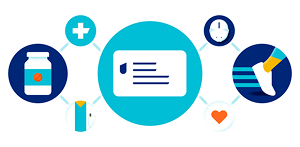If you’ve ever had a big presentation to do at work or a test to take in college, you may have been feeling anxious beforehand. It’s not so fun, right? That might include sweating or a general feeling of being overwhelmed.
Now imagine feeling worried or fearful for long periods of time. Maybe it doesn’t go away, happens all the time or feels like it’s getting worse over time. That’s what’s called an anxiety disorder.
It’s actually quite common to have an anxiety disorder. According to the National Institute of Mental Health, about 19.1% of American adults have experienced some kind of anxiety disorder in the past year. They tend to affect women more than men.
If left untreated, an anxiety disorder can even affect your physical health. You might experience a range of symptoms, which can increase your health risks.
Understanding how anxiety affects your body is an important way to help manage both your mental and physical well-being. Below, learn more about what anxiety is, the impact it can have on your physical health and what you can do to treat it.
Need help with an anxiety disorder? Consider a telehealth membership that offers direct access to mental health providers via phone, video or app. Learn more now.
What types of anxiety disorders can people have?
Not all anxiety disorders are the same. You might have a different one than your neighbor. Here are several common types:
- Generalized anxiety disorder (GAD). This is a type of anxiety disorder that makes you feel fearful, fills you with worry and a constant feeling of being overwhelmed. It could be connected to everything from your job to health and even parts of your day-to-day routine, like when it’s your turn to cook dinner or tidy up around the house.
- Panic disorder. This type of anxiety disorder often involves multiple panic attacks that seemingly come out of nowhere — but tend to be connected to another mental health or physical condition. Some people who have a panic disorder may also have agoraphobia. That’s a condition where you have a fear of becoming overwhelmed or escaping a certain situation. Examples could be large crowds or parties at a stranger’s house.
- Separation anxiety disorder. This happens when you feel really anxious when you’re apart from a loved one, like a caregiver. While it’s normal among babies and toddlers, it can also affect adults, too.
- Social anxiety disorder (social phobia). That’s a type of anxiety disorder when you feel a fear that won’t go away about how people are judging or watching you. Like the name suggests, it gets worse in social situations.
There is also a list of other phobias that someone might have doing certain activities. These phobias can make it hard to live your life in a normal way. For example, someone might feel intense anxiety flying on a plane or being around germs.
What are some of the psychological symptoms of anxiety disorders?
Depending on what type of anxiety disorder you have, you might have different symptoms. From a psychological perspective, symptoms include feeling:
- Difficulty concentrating
- Dread
- Fear
- Irritable
- On edge
- Out-of-control, obsessive thoughts
- Panic
- Uneasiness
If you’re having any of these symptoms, it’s a good idea to schedule an appointment with either your doctor or a mental health professional. (See below for more information on treatments and solutions.)
9 ways anxiety disorders can affect your physical health
Anxiety disorders can affect your physical health in a bunch of different ways, too. These symptoms can even mimic or increase the risk of more serious health conditions. Here are 9 examples of ways anxiety can affect your physical health:
- Heart issues. A common symptom of anxiety is heart palpitations. That’s when your heart beats quickly, irregularly or pounds in your chest. Over time, anxiety can put you at risk of more serious heart-related conditions such as heart attacks. While anxiety can’t cause long-term high blood pressure, it can cause it to temporarily rise. That can damage everything from your heart and blood vessels to your kidneys.
- Cold or sweaty hands. Changes in body temperature and sweating are common physical symptoms of anxiety, even in older children and teenagers. While cold, clammy hands are far from life-threatening, they can make social situations embarrassing.
- Dry mouth. Anxiety may also cause a reduction in saliva production in your mouth. This can lead to everything from bad breath to difficulty speaking or swallowing.
- Trouble sleeping. Difficulty falling or staying asleep (insomnia) is a common issue for people with anxiety. Over time, though, it can affect your overall health. For example, lack of sleep may increase your risk for serious health problems like diabetes and high blood pressure.
- Muscle tension. The inflammation caused by anxiety can lead to narrowing of the blood vessels. This decreases blood flow and oxygen to the muscles. That can make it harder for the muscles to recover or heal.
- Nausea. An uncomfortable physical reaction to anxiety could be feeling sick to your stomach.
- Numbness or tingling in the hands and feet. If your hands or feet feel numb or tingle-y, that can be a symptom of a panic attack.
- Restlessness. It might be difficult to control thoughts and feelings of anxiety. That can make you feel restless and can disrupt your daily life.
- Shortness of Breath: Oftentimes, a symptom of a panic attack is shortness of breath. That can cause you to feel even more anxious and lead to more breathing issues. It can even make someone feel like they can’t breathe at all — or are having a heart attack.
Finding the right mental health provider for you is important. Through a non-insurance telehealth membership, one monthly fee can help you get care without copays. Explore telehealth options.
What are some ways to treat an anxiety disorder?
If you think you have an anxiety disorder, you’ll want to first talk to your doctor or a mental health professional. They can help you figure out the root cause and recommend treatments. Here are some common options:
- Medication. Your doctor or a type of mental health professional called a psychiatrist, who also has a medical doctorate, can prescribe medications. (In some states, psychologists can also prescribe medication.) They might suggest trying an anti-anxiety drug, to help curb the symptoms of anxiety.
- Psychotherapy. You might also see this called talk therapy. Normally, a psychologist will provide this option. It’s a type of treatment that helps a person identify and change troubling emotions, thoughts and behaviors.
Where can you find providers to help treat your anxiety?
Some health insurance plans offer mental health benefits. For example, if you get your health insurance through the federal Health Insurance Marketplace or a state exchange, mental health and substance abuse services are considered “essential” health benefits.
If you have health insurance and your plan offers telehealth for mental health, that could be a convenient and cost-effective way to connect with a mental health professional. You can do virtual talk therapy.
But not all health insurance plans offer telehealth. One alternative could be buying a non-insurance product like a telehealth membership. It can offer telehealth services that allow you to connect with mental health professionals for talk therapy on your own time. Some memberships offer:
- Coaching and guidance
- Crisis management (though, if you’re having thoughts of suicide, you should seek emergency medical care immediately)
- Psychiatry (they can virtually write you prescriptions for medication)
Telehealth membership can offer access to general medicine doctors and dermatologists, too.
Get treatment for anxiety, depression and other mental health issues. See how a telehealth membership can help you get the virtual support you need, or call a licensed insurance agent at 1-844-211-7730 for more information.
For informational purposes only. This information is compiled by UnitedHealthcare, and/or one of its affiliates, and does not diagnose problems or recommend specific treatment. Services and medical technologies referenced herein may not be covered under your plan. Please consult directly with your primary care physician if you need medical advice.
Compliance Code:
52347-X-0625
Sources:
Boston University Center for Anxiety & Related Disorders. “Panic disorders in children and adolescents.” Retrieved from https://www.bu.edu/card/child-adolescent-treatment-at-card/conditions-we-treat-child/pda-child/ Accessed April 24, 2025.
BYU Counseling and Psychological Services. “Muscle tension.” Retrieved from https://caps.byu.edu/muscle-tension Accessed April 24, 2025.
Cleveland Clinic. “Anxiety disorders.” July 3, 2024. Retrieved from https://my.clevelandclinic.org/health/diseases/9536-anxiety-disorders
Cleveland Clinic. “Dry mouth (Xerostomia).” September 15, 2023. Retrieved from https://my.clevelandclinic.org/health/diseases/10902-dry-mouth-xerostomia
Cleveland Clinic. “How To Tell the Difference Between a Heart Attack and a Panic Attack.” January 26, 2024. Retrieved from https://health.clevelandclinic.org/the-difference-between-panic-attacks-and-heart-attacks
Mayo Clinic. “Anxiety: A cause of high blood pressure?” March 7, 2024. Retrieved from https://www.mayoclinic.org/diseases-conditions/high-blood-pressure/expert-answers/anxiety/faq-20058549
MedlinePlus. “Anxiety.” October 17, 2023. Retrieved from https://medlineplus.gov/anxiety.html
Michigan University Health & Counseling. “Anxiety disorders and panic attacks.” Retrieved from https://uhs.umich.edu/anxietypanic Accessed April 24, 2025.
National Institute of Mental Health. “Anxiety disorders.” December 2024. Retrieved from https://www.nimh.nih.gov/health/topics/anxiety-disorders
Office of Women’s Health. “Insomnia.” February 3, 2025. Retrieved from https://womenshealth.gov/a-z-topics/insomnia










